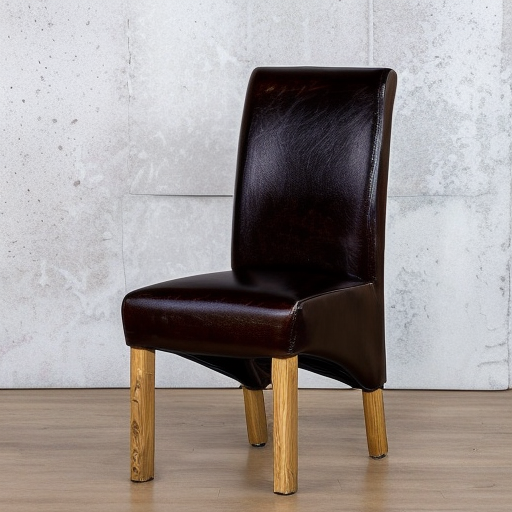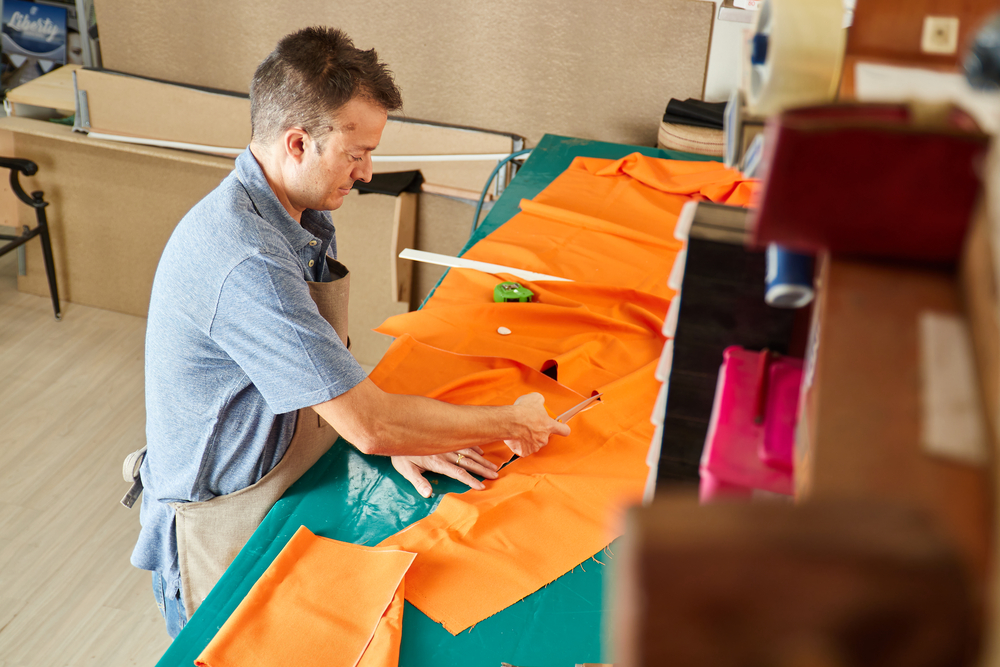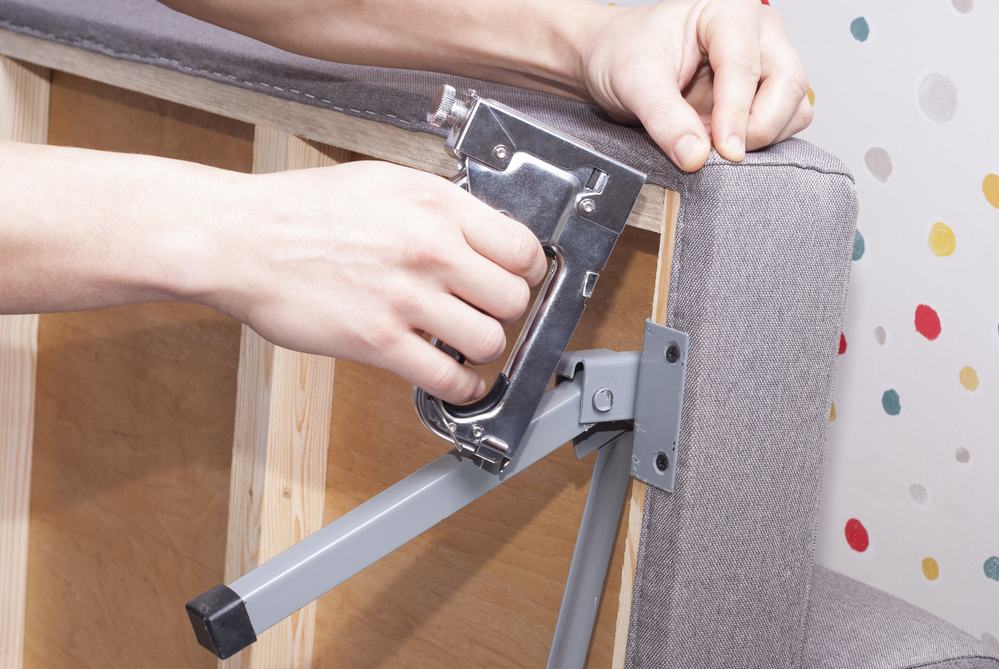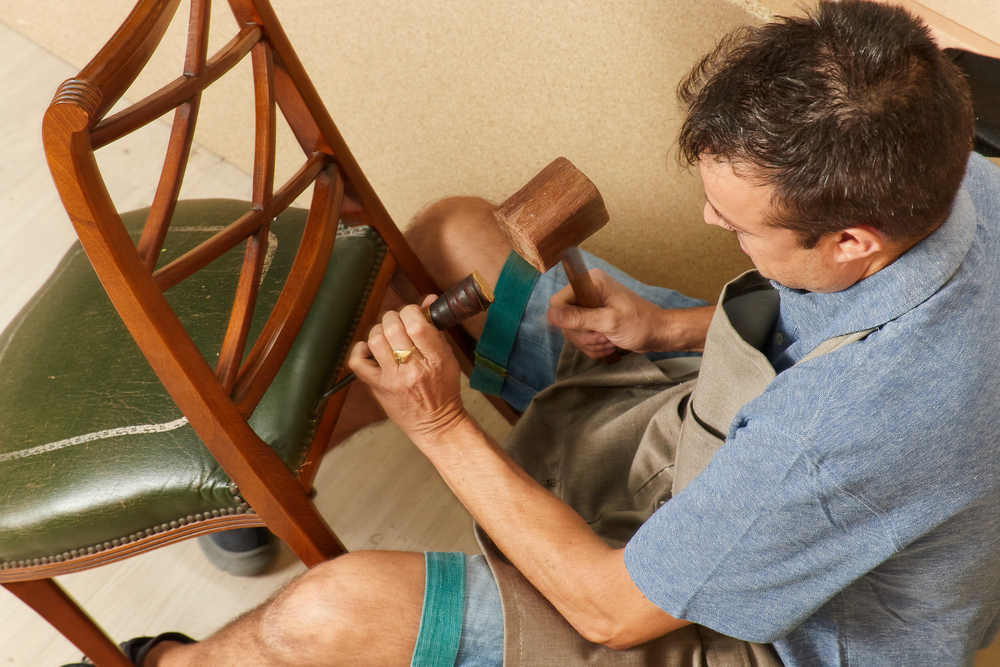Last Updated on January 18, 2023
Have you ever wondered how to reupholster a leather dining chair? Whether you have some old furniture that needs an upgrade or you are simply curious, we have got you covered, pun intended. After all, uncomfortable dining chairs with lumps in the cushioning, visible signs of sagging, or faded and ripped upholstery are not doing you any favours, right?
Reupholstering your leather dining chairs can be pretty straightforward as long as you know what you are doing. This makeover can seriously improve your overall home decor and comfort level while using them. If you are ready to refresh and reupholster your leather dining room chairs, keep reading, and you’ll be prepared to get started in no time at all.
Before You Begin: The Basics Explained
Can Leather Chairs Be Reupholstered?

Reupholstering leather dining chairs is achievable and not at all that difficult when you know what the process entails.
When you reupholster a leather chair, you can replace the leather with new leather or any other type of new upholstery fabric you like. You also get the opportunity to install new foam padding and the option for an added decorative trim of your choosing. With all of these options, you can fully transform a dining chair and restore it to its original glory, maybe even better.
If you are wondering how to reupholster a leather dining chair, chances are pretty good you already have some old ones that are in need of a refresh. However, if you are at a thrift store and come across one or two chairs that look well-built, you may want to take the plunge and embark on this upholstery project.
Gather Your Reupholstering Supplies
Before you start recovering a leather chair, we strongly recommend gathering all of your supplies first. This helps the process move more smoothly once it begins and ensures you have everything you need to accomplish the task.
If you do not already own the tools required, you may be able to rent them from a local hardware store or borrow them from friends. If you plan on reupholstering several pieces of furniture or adding them to your list of frequent DIY projects, you may want to just go ahead and invest in the required tools and materials.
You can purchase upholstery fabric and leather at most local craft stores in various colours and patterns. You can also buy material online from a myriad of fabric retailers.
What You’ll Need to Re-Upholster a Dining Room Chair:
- Old chair
- Staple gun with staples
- New fabric or leather upholstery
- New padding (cotton or foam)
- Dust cover fabric
- Craft knife
- Fabric scissors
- Pen or marker
- Tack or upholstery staple remover
- Needle nose pliers (optional)
- Upholstery hammer
- Decorative trim
How to Reupholster Leather Dining Chairs in 7 Easy Steps
Step #1: Remove the Old Leather and Padding
First things first: remove all of the old upholstery on your leather dining chair. Depending on the style of dining chair you are covering, you may need to remove leather upholstery from the seat, back, and armrests.
To remove the old upholstery, use your tack or upholstery staple remover and extract all the staples and tacks that anchor the leather to the chair frame. If the seat chair detaches from the chair frame, unscrew and separate the pieces to make removing the staples easier.
Depending on how long it has been since your dining chair has been reupholstered, the staples could be somewhat tricky to remove. Try using needle nose pliers to help pry off more difficult tacks and staples.
When the leather is removed, pull all the padding off as well. Toss the old padding in the bin but save the old fabric for a later step, especially if it came off in one piece. With any luck, you will be able to use it as a pattern for the new fabric.
Step #2: Size and Cut the New Padding
Next, it is time to measure and cut the new padding for your dining room chair. You can choose to use multiple layers of cotton padding or foam padding. Just make sure to select a material that will provide the comfort level you expect from a chair.
Cut appropriately sized cushion pieces for your dining room chair, chair seat, back, and armrests included.
Step #3: Attach the New Padding
Place the cut padding over the newly stripped parts of your dining chair. It does not matter what part of the chair you start with.
When the padding is positioned, staple it into place. Secure the perimeter and follow the previous staple pattern for the old seat cushion. We recommend placing a staple in each corner and in the middle of each edge to help anchor it initially and then moving around the edge with your staple gun to complete a full circle.
It may make it easier to lie the chair on its back when you are attaching the cushion to the back portion. Ultimately, do whatever gives you the most stable working surface based on the specific design style for your dining chair.
When the padding has been attached to all of the necessary parts of your dining room chair, use a craft knife to remove the excess padding along the edges.
Step #4: Measure and Cut the New Upholstery

Now it is time to measure and cut your new leather or upholstery fabric. Use the old fabric or leather you removed as a pattern for the new upholstery.
If you cannot save the old leather, you can lie the fabric over the chair seat, armrests, and back and trace on the material to give yourself a guide.
Cut out your measured portions of upholstery fabric. Do not cut directly on your lines but outside them to give yourself a bit of excess fabric to work with.
Step #5: Attach the New Fabric
Next up, re-cover and attach the new leather or fabric to the dining chair seat, arms, and back.
For dining room chairs with removable seats, lie it upside down on the underside of the leather or fabric and wrap it around the edges. Seeing how the edges will not be seen, there is no need to fold them under.
For the arms, back, and other types of seat cushions where the edges will not be hidden, fold the fabric over to create a smoother finished line and less pulling in the fabric itself.
When the fabric is positioned correctly, staple it in place using a staple gun. Just like with the cushioning, follow the original staple line and start by placing a staple in each corner and the middle of each edge. Then, continue stapling all around the edge in a circular motion.

Make sure you pull the fabric or leather taught on the dining chair while you work to get a snug fit. However, do not pull the corners or fabric so tight that it will make the material uneven or cause a snag.
Repeat on each section of your dining chair until you cover all portions.
Step #6: Add a Dust Cover On the Base of the Seat
While the seat’s base will not be noticed when the chair is upright, you can also choose to add a dust cover at this point. Adding a dust cover on the underside of the seat base gives your newly reupholstered dining chair a more finished look and covers the visible staples or exposed cushioning and springs within.
For dining chairs with removable seats, cut the excess upholstery fabric from around the edges before proceeding.
Cut a piece of dust cover fabric slightly larger than the seat base. Then, lie the fabric over the bottom of the seat and fold over the edges to get a more finished seam. Staple the fabric into place.
Next, use your staple gun to secure the dust cover in place. Again, start with the corners and one staple in the middle of each edge. Then staple around the entire perimeter to ensure that all of the fabric is firmly attached.
Step #7: Add a Decorative Trim to Tour Chairs
At this stage, with the majority of dining chairs, you will be left with an exposed staple line around the edges of the fabric. In order to hide seams and staples, you can easily add decorative trim. It’s possible you had to remove this in the first step. Decorative edging can also be used to stylise the edges and the dining chair overall.
While upholstery trim comes in many different styles, shapes, and sizes, a stud style trim that can be hammered in is the easiest and quickest to attach. You lie down strips of studs over the staple line and seam and then hammer them in place.
Take special care to create a straight, even line of trim that is as close to the edge as possible. This will give your dining chair a professional, polishing finished appearance.
If you are reupholstering a dining chair that only has a padded seat, you can probably skip this step. Instead, simply reattach the chair seat to the seat frame, and you are all done.
Additional Things to Consider
How Much Does it Cost to Reupholster a Leather Dining Chair?
The cost of reupholstering a leather dining chair can vary greatly. It depends on how much leather you need, but it also depends on whether or not you have the tools required and the other decorative touches you choose.
The typical leather dining room chair requires 2 to 6 metres of material to reupholster the frame completely. Upholstery fabric can range anywhere from £15 to £50 per metre or even more, depending on your stylistic preference and the quality of the material.
While you can reupholster a dining room chair on the reasonably inexpensive side, you may not be able to replace the existing leather upholstery on the chair with leather. There are plenty of affordable upholstery fabric options available. Nonetheless, keep in mind that the better quality material you use, the longer it will last before starting to show wear and tear.
Can You Refinish a Dining Chair’s Frame?
Just like with other chairs and furniture made from wood, you can also strip and refinish the frame of a dining room chair.
In addition to the fabric and the padding, you can also refinish the wood or paint on a dining room chair’s frame when needed. After all, if you are going to go through the effort to reupholster and replace the padding on a leather dining chair, you may want to consider giving the chair’s frame a little bit of care as well.
Wood decay happens naturally in forests and can also occur with your wood furniture. In addition, wood chair legs can be scuffed or become rough around the bases.
If you want to refinish an entire dining room chair, we recommend you work on the frame after removing the old leather upholstery fabric and padding. This precaution will make the process easier and more efficient. Once you paint, sand, or upgrade in whatever way you see fit, you can move on to reupholstering the padding and fabric on the chair.
How Often Do You Need to Reupholster a Dining Chair?
How often should you reupholster a dining room chair? The answer depends on how often you use the chair and how well the materials are holding up, which usually relies on the initial quality.
While these parameters leave you with an excessively large window of time, a few telltale signs can alert you to the fact it is time to reupholster a dining room chair or chairs. Of course, even if your dining room chair does not need to be reupholstered, you always can just for fun or when redesigning your home decor.
Signs Your Leather Dining Chairs Need to be Reupholstered:
- The chair’s seat or other padded areas become uncomfortable
- The chair’s padding starts to develop lumpy portions
- The chair’s seat shows visible signs of sagging
- The chair’s leather upholstery rips, tears, or develops holes
- A thinning of the chair’s material is evident
- Flaking or deep creases in the material are present
- Any other signs of severe wear and tear can be seen or are beginning to develop
New Upholstery Made Easy
After everything we have learned above, what do you think? Is it time to give the old upholstery fabric or leather on your dining room chairs an upgrade? Regardless of whether your leather dining chairs are in decline or you simply want to give them a makeover, you should now feel confident enough to reupholster them all by yourself and get excellent results.
Remember to gather all of your supplies first, choose a new fabric or leather upholstery that you love, and follow the original staple lines, and you should be covered and ready to do an amazing job. Don’t underestimate the cushioning or decorative trim, either. The padding and decorative border genuinely make all the difference when it comes to a professional and luxurious finished designer look.
Have you tried upholstering a leather dining chair and want to share your experience? Let us know what you think in the comments below.
Emily is a woman of many talents. She has a B.A. in English and enjoys writing. Emily loves accessorising her home with quality products that not only serve a purpose but also enhance the overall convenience and tranquillity of her living space; there’s nothing like coming home to your own personal sanctuary after a long day! She loves anything that can make life easier or more comfortable—from dishware to furniture to lighting fixtures.

